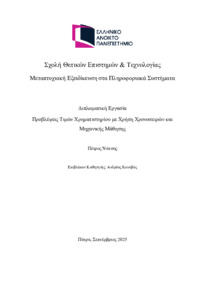- MSc thesis
- Μεταπτυχιακή Εξειδίκευση στα Πληροφοριακά Συστήματα (ΠΛΣ)
- 20 Σεπτεμβρίου 2025
- Αγγλικά
- 161
- Ανδρέας Καναβός
- Ανδρέας Καναβός | Νικόλαος Καρούσος | Εμμανουήλ Τζαγκαράκης
- Machine Learning | Financial Time Series | Stock Price Forecasting | Long Short Term Memory | Technical Analysis
- Μεταπτυχιακή Εξειδίκευση στα Πληροφοριακά Συστήματα / Μεταπτυχιακή Διπλωματική Εργασία
- 1
- 66
-
-
This dissertation investigates the application of deep learning models for next - day stock price forecasting using historical financial time series data enriched with technical indicators. Focusing on stocks listed on the NASDAQ, namely Apple Inc. (AAPL), Meta Platforms Inc. (META), Starbucks Corporation (SBUX), and Tesla Inc. (TSLA), the study implements and evaluates four advanced recurrent neural network architectures: Long Short-Term Memory (LSTM), Bidirectional LSTM (BiLSTM), Gated Recurrent Unit (GRU), and Convolutional LSTM (ConvLSTM). The models are trained using input sequences of 5, 15, and 30 trading days, with technical indicators including Exponential Moving Average, Relative Strength Indicator, Moving Average Convergence Divergence, On – Balance Volume, and Average True Range. Feature scaling is applied via MinMaxScaler, and hyperparameters, such as dropout, activation functions, optimisers, L1/L2 regularisation, batch size, and number of epochs, are tuned using Keras Tuner with random search.
Performance is evaluated using Root Mean Squared Error (RMSE), Coefficient of Determination (R²), and cumulative return comparisons against a Buy – and - Hold strategy. The results demonstrate that ConvLSTM consistently achieved the lowest RMSE across all stocks, indicating superior predictive accuracy, outperforming the Buy – and – Hold strategy. RMSprop emerged as the most stable optimiser, particularly when paired with tanh activation and an 80 – 10 – 10 data split.
The findings confirm that deep learning models, when properly optimised, can capture complex temporal dependencies and generate statistically sound and financially actionable forecasts. Moreover, the varying optimal configurations across stocks suggest the need for asset - specific tuning in algorithmic trading applications.
-
- Hellenic Open University
- Attribution-NonCommercial-NoDerivatives 4.0 Διεθνές
Stock Price Forecasting Using Time Series and Machine Learning
Προβλέψεις Τιμών Χρηματιστηρίου με Χρήση Χρονοσειρών και Μηχανικής Μάθησης (Ελληνική)
Κύρια Αρχεία Διατριβής
 Stock Price Forecasting Using Time Series and Machine Learning
Stock Price Forecasting Using Time Series and Machine Learning
Περιγραφή: Natsis Petros Stock Price Forecasting Using Time Series and Machine Learning.pdf (pdf) Book Reader
Μέγεθος: 7.1 MB

